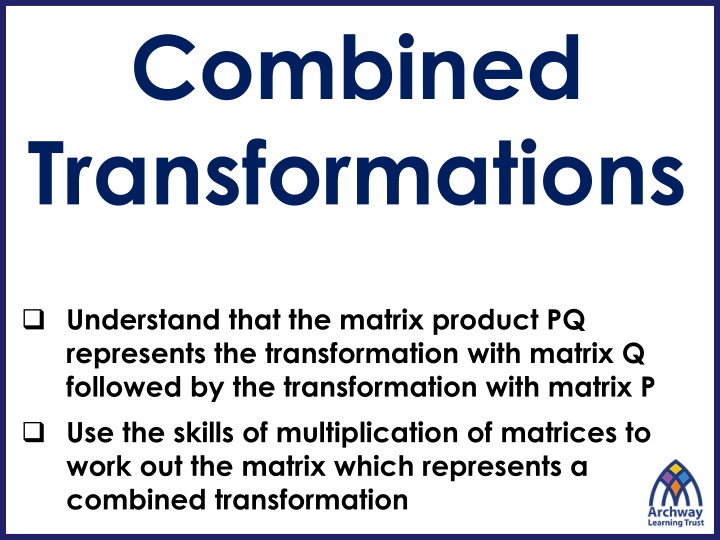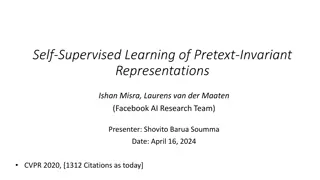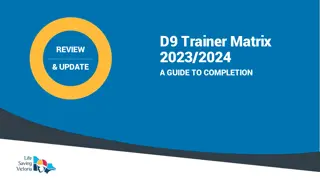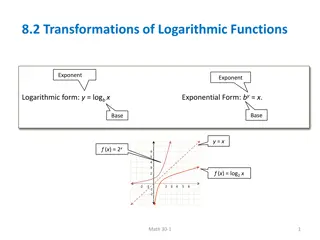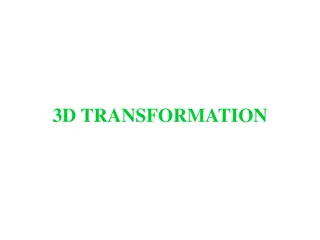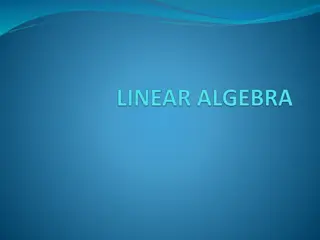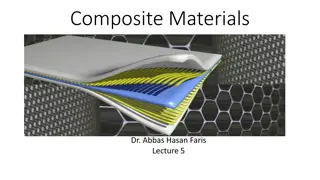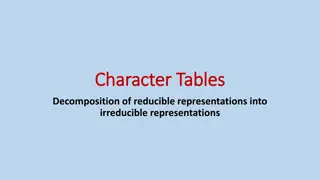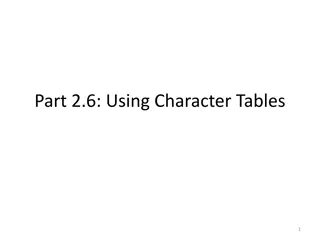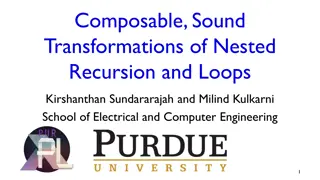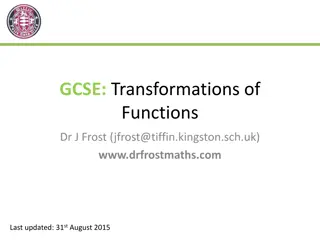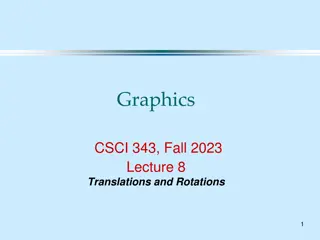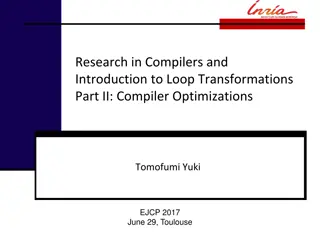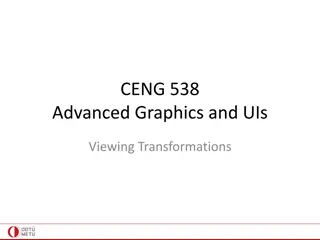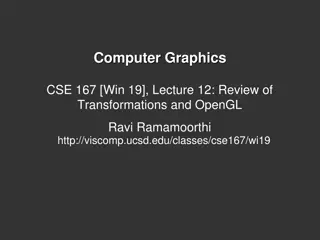Combined Matrix Transformations and Representations
Matrix transformations can be combined by multiplying the matrices in the correct order, following the rule that matrix multiplication is not commutative. The order of combined transformations is crucial, showcasing the significance of matrix sequence. The given matrices illustrate transformations like reflections and rotations, highlighting the process of transforming points through a series of matrix operations.
Uploaded on Apr 21, 2025 | 0 Views
Download Presentation

Please find below an Image/Link to download the presentation.
The content on the website is provided AS IS for your information and personal use only. It may not be sold, licensed, or shared on other websites without obtaining consent from the author.If you encounter any issues during the download, it is possible that the publisher has removed the file from their server.
You are allowed to download the files provided on this website for personal or commercial use, subject to the condition that they are used lawfully. All files are the property of their respective owners.
The content on the website is provided AS IS for your information and personal use only. It may not be sold, licensed, or shared on other websites without obtaining consent from the author.
E N D
Presentation Transcript
Combined Transformations Understand that the matrix product PQ represents the transformation with matrix Q followed by the transformation with matrix P Use the skills of multiplication of matrices to work out the matrix which represents a combined transformation
The transformations of matrices can be applied successively. Two transformations can be combined to a single transformation that maps point A directly to point A''. 1st transformation Point A single combined transformation 2nd transformation Point A' Point A''
Transformation represented by matrices can be combined by multiplying the matrices in the correct order (remembering that matrix multiplication is NOT commutative). To transform point p by transformation A and then by transformation B you would calculate Ap then calculate B(Ap). The single transformation representing this is BA. This is similar to the use of composite functions - the order of combined transformations is important. ? ?? ? ? ??? ?? The matrix ?? represents the combined transformation of ? followed by ?.
X is a reflection in the x-axis Transformation X is represented by matrix X = X maps P to the point X(P) Q is a rotation of 90 Transformation Q is represented by matrix Q = If we apply Q to the image formed by X, the point X(P), this point is mapped to the point Q(X(P)). This is shortened to QX(P). X Q
Look at the beginning and the end. The order is important and you work from right to left, so we do X then Q. The composite transformation reflection in the x-axis followed by rotation of 90o anticlockwise is represented by QX. QX Which single transformation would do the same thing?
This is the matrix which represents a reflection in the line y = x
To transform point p by transformation A then by transformation B you would calculate Ap then calculate B(Ap). The single transformation that this represents would be BA.
Point L is transformed by the matrix to the point M. Point M is then transformed by to point the point N. Work out the matrix that maps point L to point N. It is crucial that we multiply the matrices in the correct order - the matrix for the second transformation is written first in the calculation of the combined transformation.
A point ? is transformed using the matrix 1 (a reflection in the line ? = 0), followed by 0 1 0 1 0 1 0 (a reflection in the line ? = ?). (a) Give a single matrix which represents the combined transformation. (b) Describe geometrically the single transformation this matrix represents. ? ? ? ? ? ? ? ? ? ? ? ? a = ? ? Rotation 270 about the origin. b
Remember: The default direction of rotation is anticlockwise if not specified. 0 1 1 0 ? ? = 0 1 0 ? ? = 1 0 1 0 0 1 1 0 1 0 0 ?? = = 1 1 ? The question does not ask, but this represents a reflection in the line ? = 0 (the x-axis)
Combining Matrix Transformations 1. Point 3, 2 is transformed by the matrix 1 1 1 followed by a further transformation 0 by the matrix 0 2 0. 1 ? Solution: ? ? (i) Work out the matrix for the combined transformation. ? ? Solution: ( ?,?) ? (ii) Work out the co-ordinates of the image point of ?. 3 1 2 2. Point 1,4 is transformed by the matrix followed by a further transformation 2 by the matrix 1 0 2. 3 ? ? ? ? (i) Work out the matrix for the combined transformation. Solution: ?? Solution: ( ?, ??) ? (ii) Work out the co-ordinates of the image point of ?. 3. The unit square is reflected in the ?-axis followed by a rotation through 180 centre the ? Solution: ? ? ? origin. Work out the matrix for the combined transformation. ? 4. The unit square is enlarged, centre the origin, scale factor 2 followed by a reflection in the line ? = ?. Work out the matrix for the combined transformation. ? Solution: ? ? ? ?
5. 1 line ? = ?. Work out the matrix that represents a reflection in the ?-axis followed by a reflection in the line ? = ?. ? ? ? ? ? 0 1 represents a reflection in the ?-axis. 0 1 0 represents a reflection in the 0 1 [Jan 2013 Paper 2 Q17] ? ? ? ? ? ? ? = ? 0 1 0 6. The transformation matrix maps a point ? to ?. The transformation matrix 1 1 0 0 1 maps point ? to point ?. Point ? is 4,3 . Work out the coordinates of point ?. ? ? ? ? ? ? This is a rotation ?? anticlockwise. So original point ? is ? 7. The unit square OABC is transformed by reflection in the line ? = ? followed by enlargement about the origin with scale factor 2. What is the matrix of the combined transformation? ? ? ? ? ? ? [June 2012 Paper Q22] ? ? ? ? ? ? ? = ? [Set 1 Paper Q14b] ? ? ? ? ? ? ? = 3 0 0 3 and ? = 1 0 0 1. The point ? 2,7 is transformed by matrix ?? to ? . 8. ? = Show that ? lies on the line 7? + 2? = 0. ? ? ? ? ? ? ? ? ? ? ? ? ?? = ? ? + ? ?? = ?
End of Topic Review Give the value of a and b: ? 1 2? 1 2 2 11 2 3 0 ? 2 = Multiplying the top row of the matrices: 3 a + b 1 = -2 3a + b = -2 6 a + b -1 = 11 6a b = 11 Solving simultaneously, a = 1, b = -5
End of Topic Review Work out the image of point (-2, 5) following the transformation defined by the matrix 2 3 1 2 (-2, 5) must be converted to the vector 2 This vector is then multiplied by the matrix: 2 3 2 1 5 2 5=11 9 (11, 9)
End of Topic Review For the transformation defined by the matrix 1 0 0 following points: 1, work out the image of each of the (2, 1) (-4, 3) (0,4) (-5, -1) How would you describe this transformation? Two choices: 1. Convert each coordinate into a vector, multiply by 1 converting result back into a coordinate. 2. Recognise that the matrix is a reflection in the x-axis, and subsequently multiply all y-values by -1 (think about it): (2, -1) (-4, -3) (0, -4) (-5, 1) 0 1 before 0 Simples!
